Abstract
OBJECTIVE: Many surgeons continue to place a prophylactic drain in the pelvis after completion of a colorectal anastomosis, despite considerable evidence that this practice may not be useful. The authors conducted a systematic review and meta-analysis of randomized controlled trials to determine if placement of a drain after a colonic or rectal anastomosis can reduce the rate of complications. METHODS: A search of the Medline database of English-language articles published from 1987 to 1997 was conducted using the terms "colon," "rectum," "postoperative complications," "surgical anastomosis," and "drainage." A manual search was also conducted. Four randomized controlled trials, including a total of 414 patients, were identified that compared the routine use of drainage of colonic and/or rectal anastomoses to no drainage. Two reviewers assessed the trials independently. Trial quality was critically appraised using a previously published scale, and data on mortality, clinical and radiologic anastomotic leakage rate, wound infection rate, and major complication rate were extracted. RESULTS: The overall quality of the studies was poor. Use of a drain did not significantly affect the rate of any of the outcomes examined, although the power of this analysis to exclude any difference was low. Comparison of pooled results revealed an odds ratio for clinical leak of 1.5 favoring the control (no drain) group. Of the 20 observed leaks among all four studies that occurred in a patient with a drain in place, in only one case (5%) did pus or enteric content actually appear in the effluent of the existing drain. CONCLUSIONS: Any significant benefit of routine drainage of colon and rectal anastomoses in reducing the rate of anastomotic leakage or other surgical complications can be excluded with more confidence based on pooled data than by the individual trials alone. Additional well-designed randomized controlled trials would further reinforce this conclusion.
Full text
PDF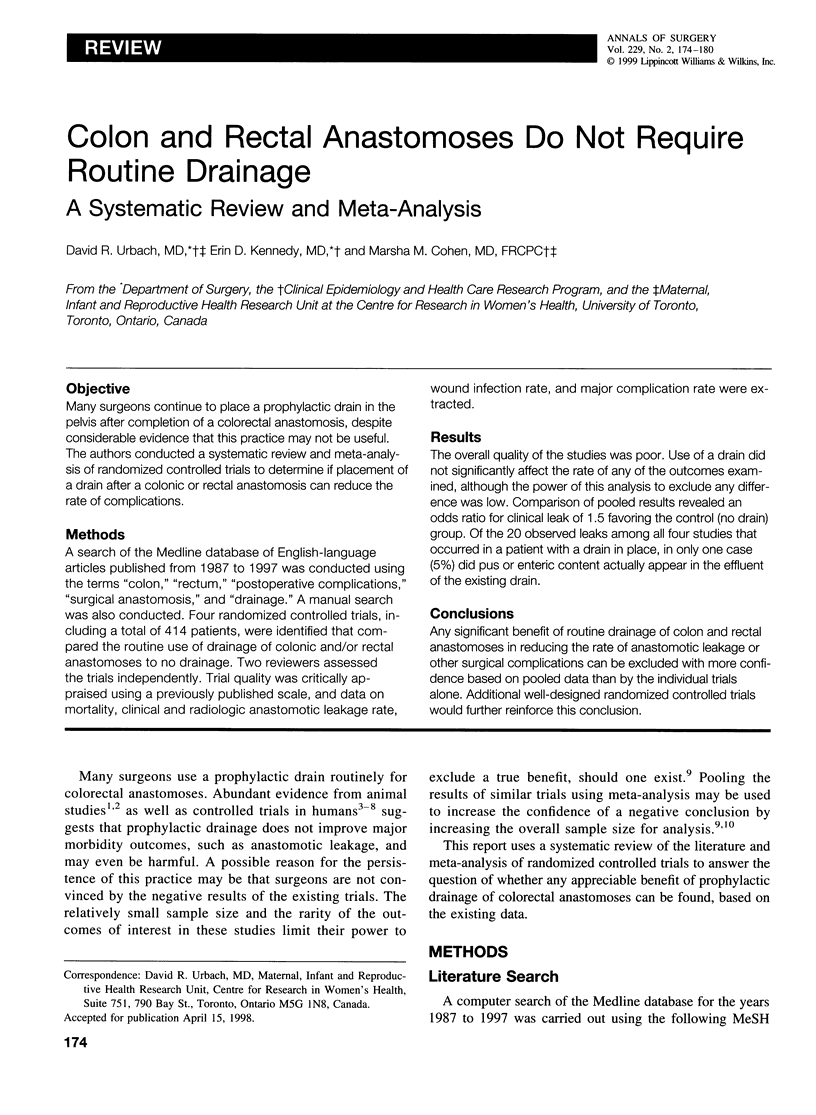
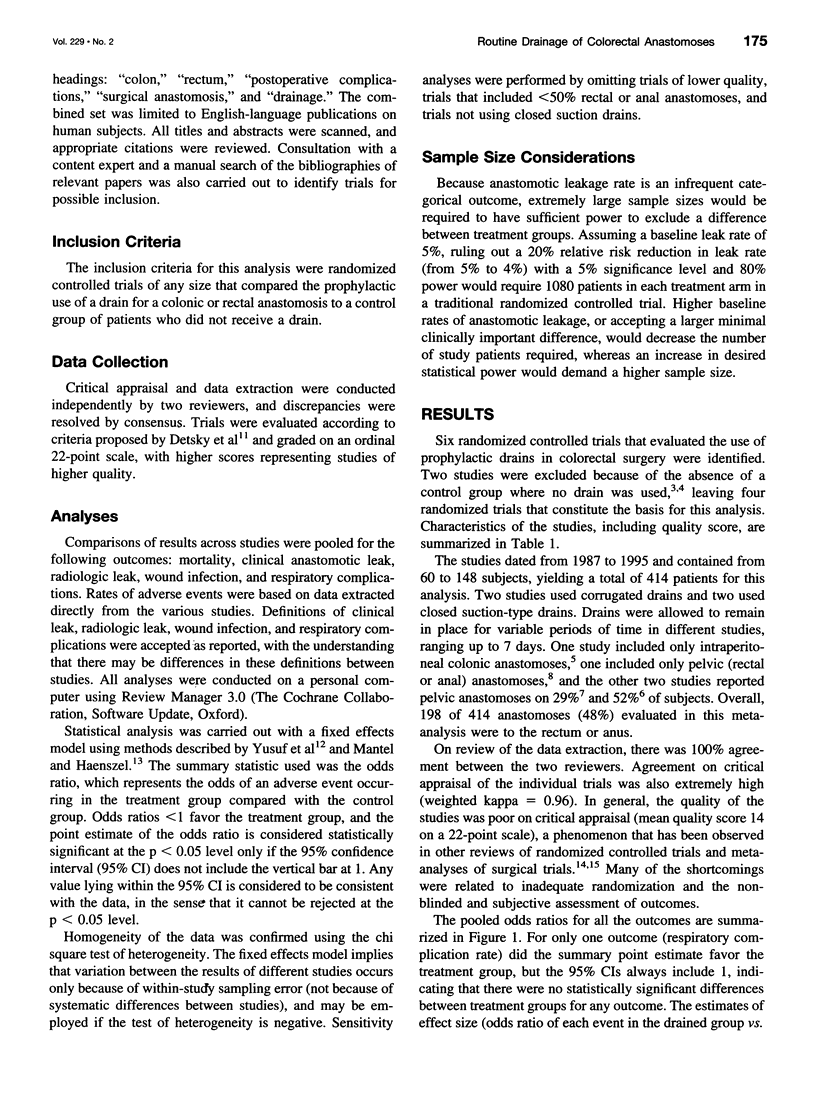
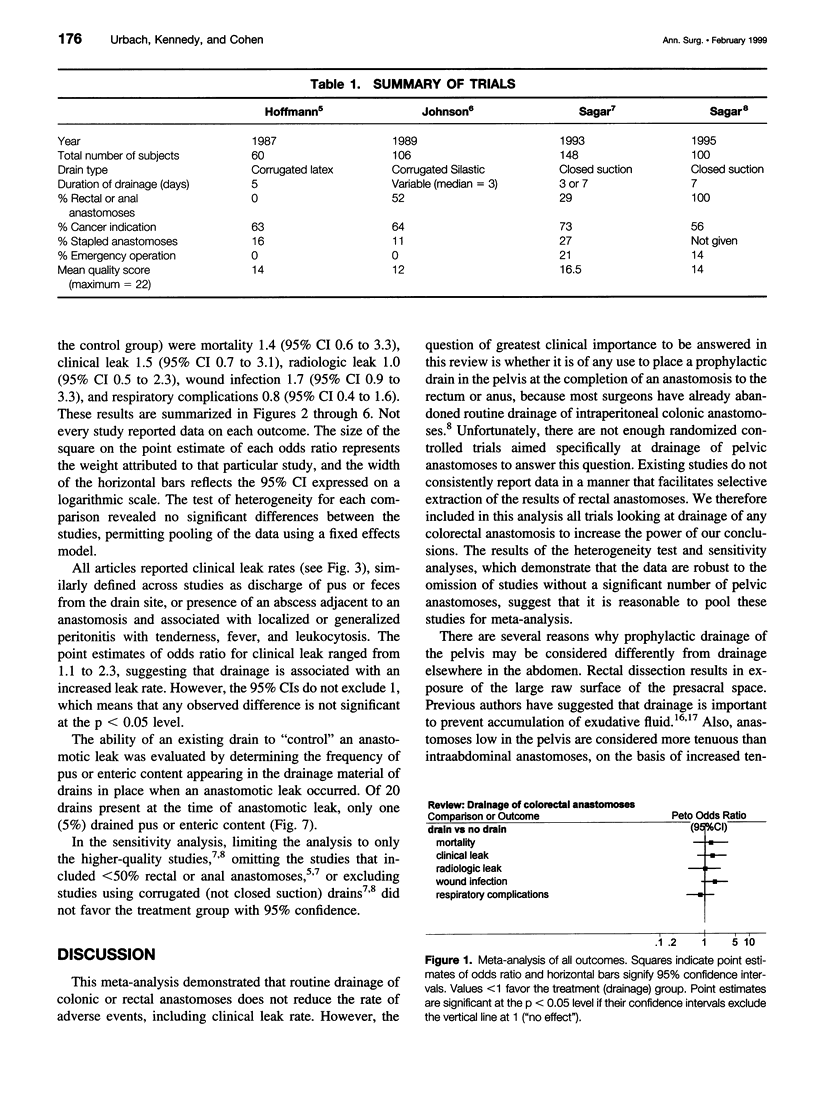
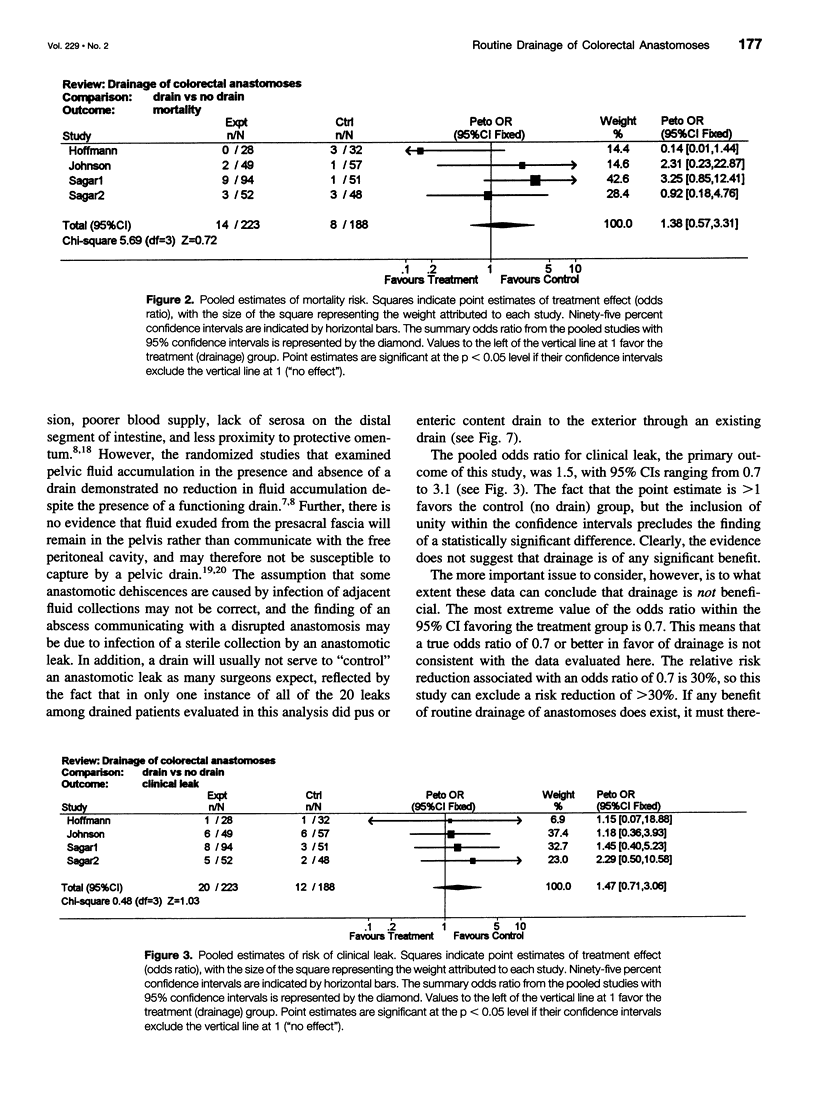
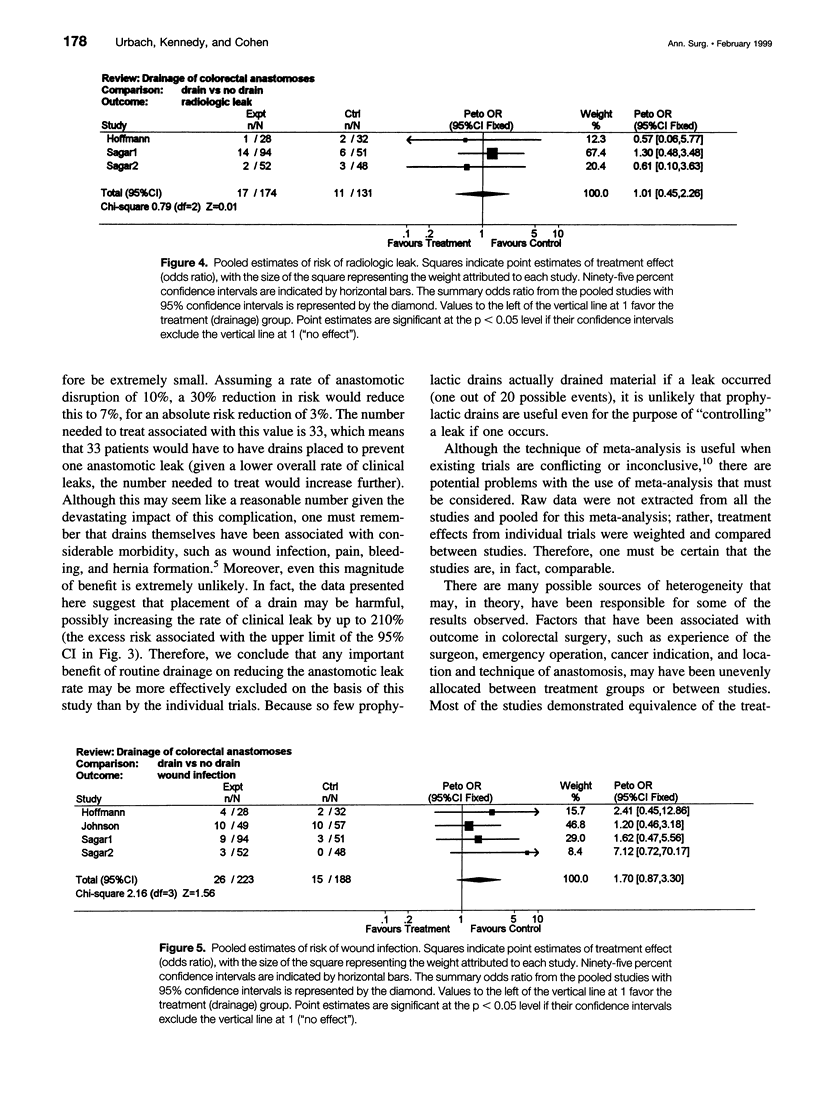
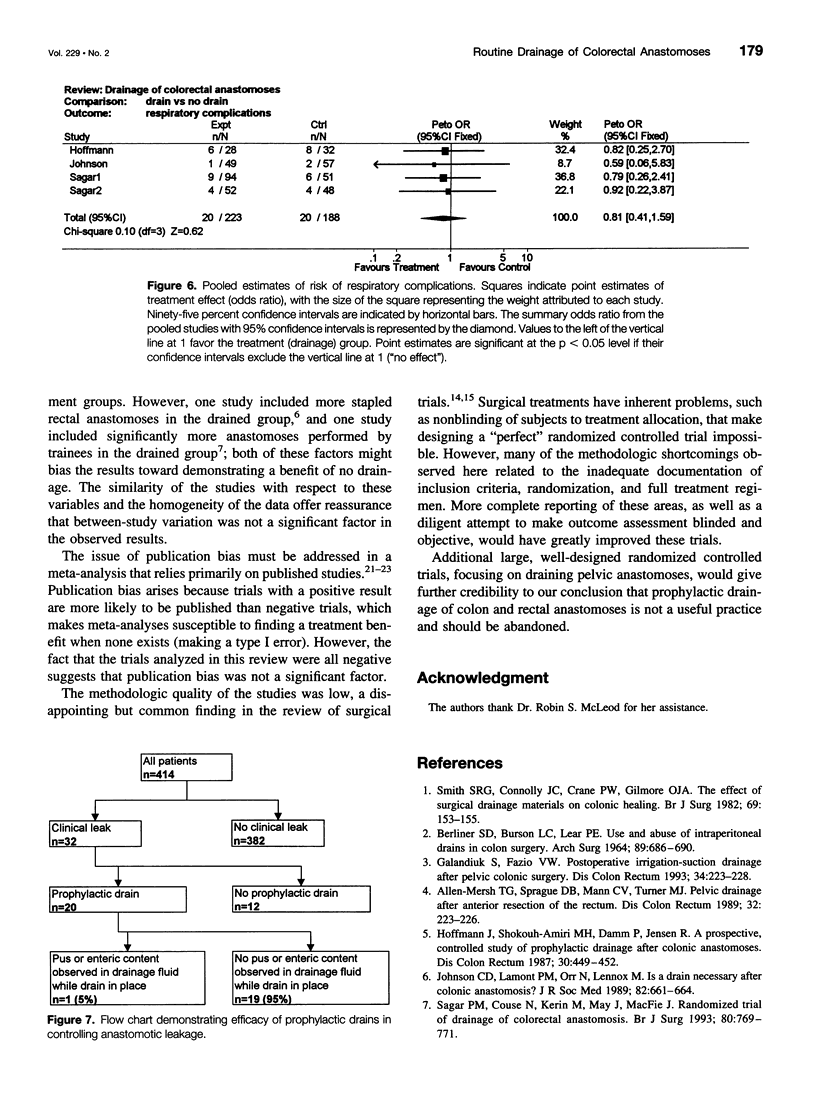
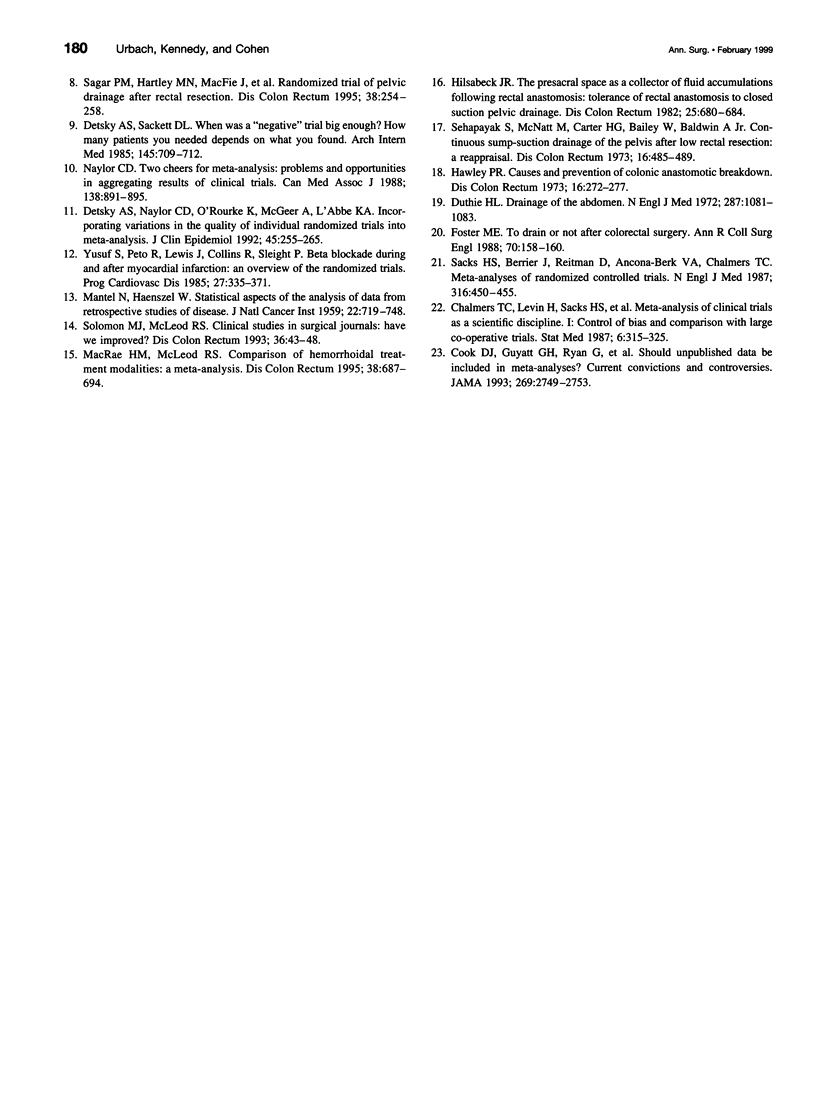
Selected References
These references are in PubMed. This may not be the complete list of references from this article.
- Allen-Mersh T. G., Sprague D. B., Mann C. V., Turner M. J. Pelvic drainage after anterior resection of the rectum. Dis Colon Rectum. 1989 Mar;32(3):223–226. doi: 10.1007/BF02554533. [DOI] [PubMed] [Google Scholar]
- BERLINER S. D., BURSON L. C., LEAR P. E. USE AND ABUSE OF INTRAPERITONEAL DRAINS IN COLON SURGERY. Arch Surg. 1964 Oct;89:686–689. doi: 10.1001/archsurg.1964.01320040102017. [DOI] [PubMed] [Google Scholar]
- Chalmers T. C., Levin H., Sacks H. S., Reitman D., Berrier J., Nagalingam R. Meta-analysis of clinical trials as a scientific discipline. I: Control of bias and comparison with large co-operative trials. Stat Med. 1987 Apr-May;6(3):315–328. doi: 10.1002/sim.4780060320. [DOI] [PubMed] [Google Scholar]
- Cook D. J., Guyatt G. H., Ryan G., Clifton J., Buckingham L., Willan A., McIlroy W., Oxman A. D. Should unpublished data be included in meta-analyses? Current convictions and controversies. JAMA. 1993 Jun 2;269(21):2749–2753. [PubMed] [Google Scholar]
- Detsky A. S., Naylor C. D., O'Rourke K., McGeer A. J., L'Abbé K. A. Incorporating variations in the quality of individual randomized trials into meta-analysis. J Clin Epidemiol. 1992 Mar;45(3):255–265. doi: 10.1016/0895-4356(92)90085-2. [DOI] [PubMed] [Google Scholar]
- Detsky A. S., Sackett D. L. When was a "negative" clinical trial big enough? How many patients you needed depends on what you found. Arch Intern Med. 1985 Apr;145(4):709–712. [PubMed] [Google Scholar]
- Duthie H. L. Drainage of the abdomen. N Engl J Med. 1972 Nov 23;287(21):1081–1083. doi: 10.1056/NEJM197211232872107. [DOI] [PubMed] [Google Scholar]
- Galandiuk S., Fazio V. W. Postoperative irrigation-suction drainage after pelvic colonic surgery. A prospective randomized trial. Dis Colon Rectum. 1991 Mar;34(3):223–228. doi: 10.1007/BF02090161. [DOI] [PubMed] [Google Scholar]
- Gilbert J. M., Trapnell J. E. Intraoperative testing of the integrity of left-sided colorectal anastomoses: a technique of value to the surgeon in training. Ann R Coll Surg Engl. 1988 May;70(3):158–160. [PMC free article] [PubMed] [Google Scholar]
- Hawley P. R. Causes and prevention of colonic anastomotic breakdown. Dis Colon Rectum. 1973 Jul-Aug;16(4):272–277. doi: 10.1007/BF02587700. [DOI] [PubMed] [Google Scholar]
- Hilsabeck J. R. The presacral space as a collector of fluid accumulations following rectal anastomosis: tolerance of rectal anastomosis to closed suction pelvic drainage. Dis Colon Rectum. 1982 Oct;25(7):680–684. doi: 10.1007/BF02629540. [DOI] [PubMed] [Google Scholar]
- Hoffmann J., Shokouh-Amiri M. H., Damm P., Jensen R. A prospective, controlled study of prophylactic drainage after colonic anastomoses. Dis Colon Rectum. 1987 Jun;30(6):449–452. doi: 10.1007/BF02556495. [DOI] [PubMed] [Google Scholar]
- Johnson C. D., Lamont P. M., Orr N., Lennox M. Is a drain necessary after colonic anastomosis? J R Soc Med. 1989 Nov;82(11):661–664. doi: 10.1177/014107688908201109. [DOI] [PMC free article] [PubMed] [Google Scholar]
- MANTEL N., HAENSZEL W. Statistical aspects of the analysis of data from retrospective studies of disease. J Natl Cancer Inst. 1959 Apr;22(4):719–748. [PubMed] [Google Scholar]
- MacRae H. M., McLeod R. S. Comparison of hemorrhoidal treatment modalities. A meta-analysis. Dis Colon Rectum. 1995 Jul;38(7):687–694. doi: 10.1007/BF02048023. [DOI] [PubMed] [Google Scholar]
- Naylor C. D. Two cheers for meta-analysis: problems and opportunities in aggregating results of clinical trials. CMAJ. 1988 May 15;138(10):891–895. [PMC free article] [PubMed] [Google Scholar]
- Sacks H. S., Berrier J., Reitman D., Ancona-Berk V. A., Chalmers T. C. Meta-analyses of randomized controlled trials. N Engl J Med. 1987 Feb 19;316(8):450–455. doi: 10.1056/NEJM198702193160806. [DOI] [PubMed] [Google Scholar]
- Sagar P. M., Couse N., Kerin M., May J., MacFie J. Randomized trial of drainage of colorectal anastomosis. Br J Surg. 1993 Jun;80(6):769–771. doi: 10.1002/bjs.1800800640. [DOI] [PubMed] [Google Scholar]
- Sagar P. M., Hartley M. N., Macfie J., Mancey-Jones B., Sedman P., May J. Randomized trial of pelvic drainage after rectal resection. Dis Colon Rectum. 1995 Mar;38(3):254–258. doi: 10.1007/BF02055597. [DOI] [PubMed] [Google Scholar]
- Sehapayak S., McNatt M., Carter H. G., Bailey W., Baldwin A., Jr Continuous sump-suction drainage of the pelvis after low anterior resection: a reappraisal. Dis Colon Rectum. 1973 Nov-Dec;16(6):485–489. doi: 10.1007/BF02588875. [DOI] [PubMed] [Google Scholar]
- Smith S. R., Connolly J. C., Crane P. W., Gilmore O. J. The effect of surgical drainage materials on colonic healing. Br J Surg. 1982 Mar;69(3):153–155. doi: 10.1002/bjs.1800690313. [DOI] [PubMed] [Google Scholar]
- Solomon M. J., McLeod R. S. Clinical studies in surgical journals--have we improved? Dis Colon Rectum. 1993 Jan;36(1):43–48. doi: 10.1007/BF02050300. [DOI] [PubMed] [Google Scholar]
- Yusuf S., Peto R., Lewis J., Collins R., Sleight P. Beta blockade during and after myocardial infarction: an overview of the randomized trials. Prog Cardiovasc Dis. 1985 Mar-Apr;27(5):335–371. doi: 10.1016/s0033-0620(85)80003-7. [DOI] [PubMed] [Google Scholar]


